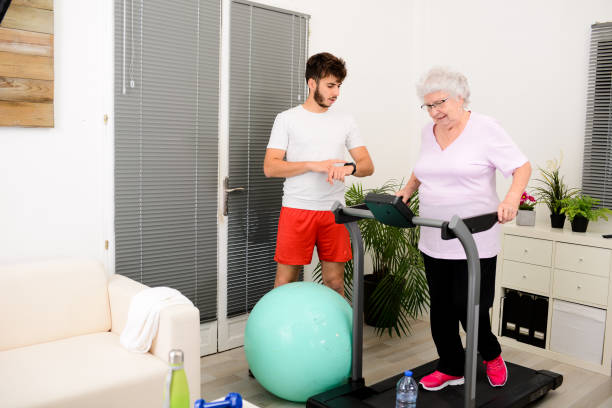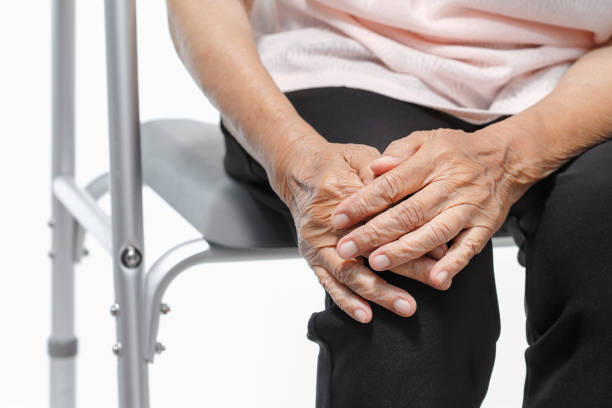Introduction

Exercise has long been known to have numerous health benefits, but there is now growing evidence that physical activity can also play an important role in reducing the risk of falls for people with Parkinson's disease. By improving balance, strength, and flexibility, exercise can help people with Parkinson's remain independent and active.
In this blog post, we will discuss why exercise is so important for people with Parkinson's and explore the various exercises that can help reduce the risk of falls. We will also provide tips on how to get started with an exercise program and outline some potential risks to look out for. By understanding the role of exercise in reducing the risk of falls, we can help people with Parkinson's stay healthy, active, and independent.
Five risk factors for people with Parkinson's that can reduce exercise?
When considering exercise for people with Parkinson's, it is important to remember that certain risk factors can increase the fall risk. These include:
1. Muscle weakness and decreased coordination:

Mobility and balance issues due to muscle weakness and decreased coordination are common in people with Parkinson's, making them more prone to falls; as people with Parkinson's experience a decline in motor skills, specifically strength, and coordination, their risk for falling increases. Exercise can help reduce the risk of falls by strengthening muscles and improving coordination. Regular exercises such as Tai Chi and yoga can help to improve flexibility, balance, and strength while also helping with coordination.
2. Rigidity and Spasticity:
People with Parkinson's often experience rigidity and spasticity of their muscles, which can cause difficulty walking or moving around. This can increase the risk of falls. Regular exercise is important for people with Parkinson's to help reduce rigidity and muscle spasticity. Examples of exercises that can help improve this include stretching, resistance training, and aerobic activities such as biking or elliptical machines.
3. Medication Side Effects:
Another risk factor for falling is medication side effects. People with Parkinson's often take medications to help manage their symptoms, and these can have side effects such as dizziness or lightheadedness that can increase the risk of falls. Regular exercise can help improve balance and coordination while also reducing the effects of any medication side effects.
4. Cognitive Impairment:
People with Parkinson's may experience cognitive impairment, affecting their ability to focus, remember instructions, and multitask, increasing the risk of falling. Exercise has been found to improve cognitive function and reduce the risk of falls by improving coordination and balance.
5. Visual Impairment:
Visual impairment is another risk factor for falls, as it can make it difficult to see obstacles or judge distances correctly. Regular exercise has been found to improve visual acuity and overall vision, reducing the risk of falls. If you or someone close to you has Parkinson's, it is important to understand the role of exercise in reducing the risk of falls. Exercise can help improve balance, strength, coordination, and cognitive function while reducing medication side effects and visual impairment. By understanding the risks involved and properly managing them with exercise, people with Parkinson's can stay active and independent.
What exercises reduce falls?

Exercises that target balance, strength, and flexibility can reduce falls in people with Parkinson's. Balance exercises are important for improving coordination, posture, and reaction time to changes in terrain or surfaces. Strength-training exercises like squats and lunges help build muscle strength and stability, reducing the risk of falls by making it easier for the person to help them maintain their balance.
Flexibility exercises, such as stretching and yoga, can also benefit people with Parkinson's by improving their range of motion and preparing the body for better control in everyday activities. Additionally, aerobic exercise is important since it increases overall fitness levels, which can lead to improved mobility and steadiness.
Overall, exercise is important in reducing the risk of falls for people with Parkinson's. Exercise can help improve balance, strength, and flexibility while increasing overall fitness levels. With regular practice and following a structured program, these exercises can positively reduce the risk of falls in people with Parkinson's.
How can you reduce the risk of injury during exercise?
Exercising regularly and safely is important to reduce your fall risk. Regular physical activity can help balance, coordination, and muscle strength, which are key to preventing falls when living with Parkinson's.
Here are a few tips for reducing your risk of injury during physical activity:
-
Start slowly: Start with gentle movements and gradually increase the intensity over time.
-
Wear the right gear: Make sure to wear supportive, non-slip shoes with good grip and laces that are tied tightly. Additionally, you should avoid any clothing or jewelry that you could trip on while exercising.
-
Stay hydrated: Make sure to drink plenty of water before, during, and after exercise.
-
Talk to your doctor: It's important to discuss the type and intensity of exercise that is right for you with your doctor or healthcare provider. They can also help you find an appropriate fitness program or class.
The good news is that regular exercise can help reduce your risk of falls and keep you feeling strong, balanced, and healthy. With the right precautions and guidance, physical activity can be a safe and enjoyable part of your daily routine.
How much does exercise reduce the risk of Parkinson's disease?
Exercise has been found to reduce the risk of falling and other mobility issues associated with Parkinson's Disease. Regular physical activity can help improve balance, coordination, muscle strength, reaction time, and cognitive function, all of which are important for preventing falls in people with Parkinson's. Studies have also shown that exercise can reduce the impact of medications and side effects and improve quality of life.
Exercise also has the potential to reduce the progression of Parkinson's Disease by reducing inflammation and oxidative stress. Studies have indicated that regular physical activity can improve neurological function, slow down disease progression, and even extend survival in some cases. Therefore, exercise should be regularly included in a person's lifestyle to help reduce the risk of Parkinson's Disease.
However, discussing any exercise plans with your healthcare provider to ensure that you are engaging in activities appropriate to your needs and abilities is important. Exercise can be an effective way to reduce the risk of falls and other mobility issues associated with Parkinson's Disease while at the same time improving quality of life. With proper guidance and precaution, physical activity can be a safe and beneficial part of your daily routine.
Benefits of physical activity for Parkinson's Patients
Here are some of the key benefits of physical activity for people with Parkinson's:
-
Improved balance and coordination: Regular exercise can help individuals with Parkinson's maintain balance and coordination, reducing the risk of falls.
-
Increased strength: Exercise helps to build strength in muscles that are affected by PD, improving mobility, posture, and stability.
-
Improved mood and quality of life: Exercise can help to reduce anxiety and depression, as well as improve feelings of well-being. It can also help people with PD maintain their independence for longer.
-
Slowed progression of symptoms: Studies have shown that exercise may slow the progression of Parkinson's symptoms, such as tremors, rigidity, and slowness of movement.
Assessing the importance of engaging in regular physical activity for long-term health management
Regular physical activity is a critical component of long-term health management for people with Parkinson's disease and is important in reducing the risk of falls. Evidence has shown that exercise can help improve balance and coordination, and overall physical strength. Exercise can also manage symptoms such as freezing of gait, bradykinesia (slow movement), and rigidity.
Types of exercise that target these areas include:
-
Strength and resistance training activities such as weight lifting, core strengthening exercises (e.g., planks, bridges), and balance and proprioceptive training drills can be done in a standing or seated position.
-
Aerobic exercises such as brisk walking, jogging, and cycling.
-
Stretching activities.
It is important to note that exercise should be tailored to each individual's ability level and needs, so consulting with a health professional before beginning any new physical activity is recommended.
By engaging in regular physical activity and exercising the right muscles with the correct intensity, frequency, and duration, people with Parkinson's can reduce the risk of falls and maintain a better quality of life. Additionally, exercise has been shown to help improve mental health, promote social interaction and increase overall well-being. Individuals with Parkinson's must recognize the importance of regular physical activity to maintain long-term health management and reduce the risk of falls.
FAQ's
What is the main cause of falling in Parkinson's disease?
The main cause of falls in people with Parkinson's is a combination of various factors, including impaired balance and coordination, reduced muscle strength and flexibility, freezing of gait, and other mobility issues.
What are the exercise recommendations for Parkinson's patients?
Exercises for individuals with Parkinson's should be tailored to meet their needs and abilities. Generally, activities such as strength and resistance training, balance and proprioceptive exercises, aerobic exercise, and stretching are recommended. Discussing your individual exercise plan with a health professional to ensure that you are engaging in the correct type of exercise for your ability level and medical condition is important.
How to exercise with Parkinson's?
When exercising with Parkinson's, it is important to focus on activities that target the specific areas of impairment. Strength and resistance training, balance and proprioceptive exercises, aerobic exercise (e.g., walking or cycling), and stretching are all recommended for people with Parkinson's.
Does exercise increase dopamine in Parkinson's?
While exercise can help to improve overall physical strength, balance, and coordination in people with Parkinson's, it is not known if exercise increases dopamine levels. However, studies have shown that regular physical activity can lead to improved mood, better quality of life, and slowed progression of symptoms.
Is exercise a treatment for Parkinson's disease?
Exercise is not a treatment for Parkinson's, but it can be an important tool to help manage symptoms and reduce the risk of falls. Regular physical activity can also lead to improved mood, better quality of life, and slowed progression of symptoms. Discussing an individualized exercise plan with a health professional before beginning any new physical activity is important.
Conclusion
I hope that the information above has provided an understanding of the role of exercise in reducing the risk of falls for people with Parkinson's. Exercise can help to improve overall physical strength, balance, and coordination, as well as manage symptoms such as freezing of gait, bradykinesia (slow movement), and rigidity. It is important to discuss an individualized exercise plan with a health professional before beginning any new physical activity and remember that it is never too late to start exercising.

